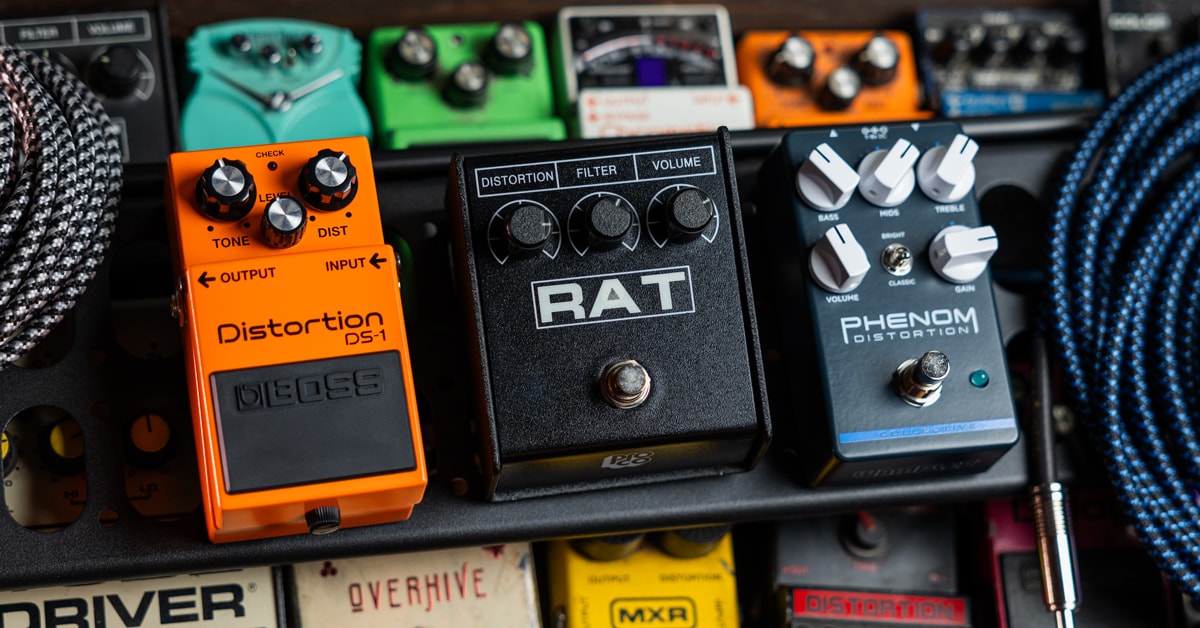Distortion is one of the most essential and satisfying sounds at a guitar player’s disposal, capable of transforming a generic clean tone with complex, harmonically rich saturation for scorching rhythms and sizzling leads. It takes an existing signal and applies hard clipping, adding second- and third-order harmonics that result in an immediately distinguishable sound integral to the electric guitar itself. The best distortion pedals fundamentally offer higher gain than an overdrive and a more controllable, articulate style of saturation than fuzz, establishing a baseline sound for a wide variety of genres.
Whether you’re tricking out a clean, pedal-platform amp with a whole suite of effects, or adding another gain stage in front of your favorite dirty amplifier, distortion pedals supply all the firepower you need to take your sound to the next level.
If you want to learn more about the origins and evolution of distortion, check out The History of the Distortion Pedal.
Table of Contents
Comparing the Top Distortion Pedals
The Best Distortion Pedals of 2025
BOSS DS-1 Distortion
BOSS MT-2W Metal Zone Distortion
EarthQuaker Devices Zoar Dynamic Audio Grinder Distortion
Electro-Harmonix Hell Melter Distortion
Fender Pugilist Distortion
JHS PackRat Distortion
Keeley Filaments Distortion
MXR M104 Distortion+
ProCo RAT2 Distortion
Wampler Phenom Distortion
Get Down and Dirty With a New Distortion Pedal
Comparing the Top Distortion Pedals
|
Distortion Pedal |
Tonal Characteristics |
Power Draw |
|
Crunch that can be bright and cutting, or rounded and mellow |
9V, 10mA |
|
|
Extreme high gain with focused midrange and exceptional clarity |
9V, 35mA |
|
|
Versatile overdriven, fuzzy or medium-high-gain distortion that’s dynamic and responsive |
9V–18V, 10mA |
|
|
“Buzzing” high-gain sound associated with early Swedish death metal |
9V, 140mA |
|
|
Two-stage gain covering everything from bluesy crunch to metal |
9V, 88mA |
|
|
Cutting, punchy fuzz-distortion that remains articulate under gain |
9V, 100mA max. |
|
|
Liquid, saturated high gain that cleans up enough to crunch |
9V–18V, 10mA |
|
|
No-nonsense overdriven crunch and fuzz-like distortion |
9V, 2.5mA |
|
|
Tight and gritty, with gain on tap for overdrive, distortion and fuzz |
9V, 1.6mA |
|
|
Smooth, robust, tube-like distortion with responsive dynamics |
9V–18V, 5mA |
The Best Distortion Pedals of 2025
BOSS DS-1 Distortion
Why You Want to Buy It: The BOSS DS-1 is an iconic, benchmark distortion pedal used by countless rock legends since its inception in 1978.
Things to Consider:
- Powered by 9V battery or 9V DC input
- Primarily voiced for gritty rock tones
- Not suited for modern high-gain metal
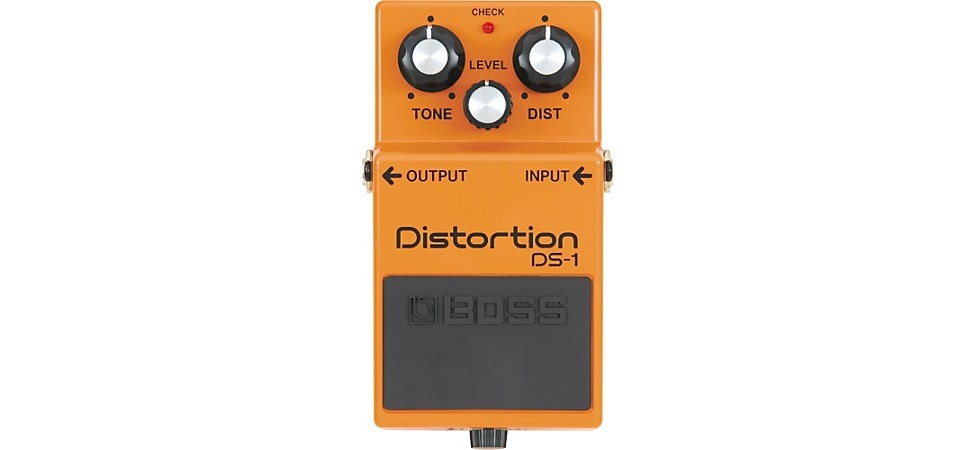
Pictured: BOSS DS-1 Distortion Pedal
In an age where most gain pedals were of the fuzz flavor, the BOSS DS-1 Distortion blew doors down with a tight, assertive style of hard clipping, and was an influential piece of the tonal puzzle for the burgeoning punk, hard rock and metal scenes of the era. Steve Vai, Joe Satriani, Prince, John Frusciante and Kurt Cobain are a handful of notable DS-1 players, each managing to pull their own unique tone from the little orange box.
The BOSS DS-1 is capable of mildly driving an amplifier at lower gain settings or tearing it to shreds with vicious rock distortion. Its famous tilt EQ simultaneously boosts highs and cuts lows as you turn it up, while moving counterclockwise does the opposite. Tones range from sharp and biting to full-bodied and warm, and this distortion pedal does a stellar job of keeping the actual sound of your guitar and pickups intact. BOSS also offers a Made in Japan version, the DS-1W, which offers an additional "Custom" mode that provides even fatter distortion and enhanced touch sensitivity.
BOSS MT-2W Metal Zone Distortion
Why You Want to Buy It: The BOSS Metal Zone encapsulates the high-gain sounds of the ’90s and, with a little Waza Craft refinement, takes on tight, technical contemporary metal.
Things to Consider:
- Powered by 9V battery or 9V DC input
- Markedly mid-focused character
- Voiced for high-gain metal
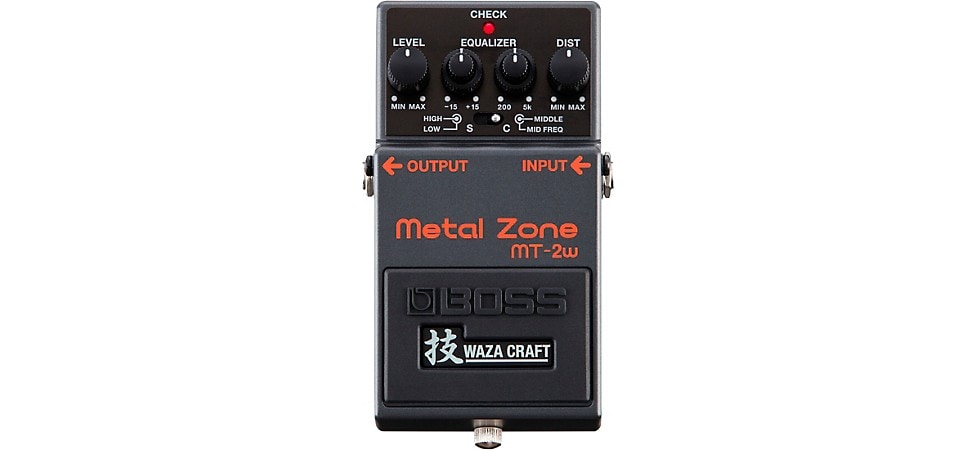
Pictured: BOSS MT-2W Waza Craft Distortion Pedal
Introduced in 1991, the original MT-2 offered savage saturation with a laser-focused midrange and 3-band parametric EQ. The BOSS MT-2W Waza Craft builds on a legacy started over 30 years ago, retaining the distortion pedal’s infamous sonic signature while improving clarity, reducing noise and adding two distinct voices.
Standard mode offers the familiar, extreme breakup of the original Metal Zone, with a slightly smoother midrange, refined EQ bandwidth, more precise attack and even greater articulation. Custom mode catapults the MT-2W into the modern era of high-gain metal, rounding off the low mids and tightening the bass for punishing down-tuned chugs. Whether you’re thrashing throwback riffs or getting down on 8-string destruction, this distortion pedal has you covered.
Searching for the heaviest of distortion pedals? Check out our guide to The Best Distortion Pedals for Metal.
EarthQuaker Devices Zoar Dynamic Audio Grinder Distortion
Why You Want to Buy It: If you’re after a distortion pedal with a dynamic response that feels like an amp, then the EarthQuaker Devices Zoar is for you.
Things to Consider:
- Voltage of power supply alters tonality
- True-bypass operation
- Transistor-based, medium-high-gain distortion
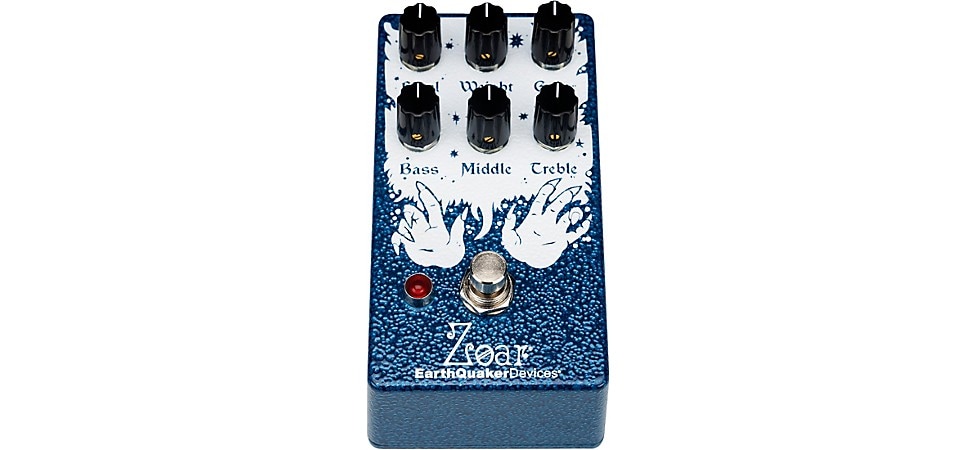
Pictured: EarthQuaker Devices Zoar Dynamic Audio Grinder Distortion Pedal
The Zoar Dynamic Audio Grinder by EarthQuaker Devices covers a broad tonal spectrum, with various settings yielding sparkling, transparent overdriven sounds; woofy, blown-out fuzz; or tight, articulate saturation. Of the six onboard parameters, Weight plays a heavy role in defining the character of the distortion, controlling the overall amount of low end. Balancing the Weight and Gain settings ultimately determines whether the Zoar sounds like a distortion or a fuzz.
Its passive 3-band EQ is modeled after a classic Fender tone stack, modified to work within the Zoar’s circuit. Overlapping crossovers mean each band is highly interactive with the other, and a little bit of adjustment goes a long way. What’s more, you can power this pedal at higher voltages of up to 18V, which results in tighter lows and even greater articulation—plus, the Zoar distortion sounds phenomenal on bass.
Electro-Harmonix Hell Melter Distortion
Why You Want to Buy It: The notorious “buzzsaw” sound of early Swedish death metal is alive and well in the EHX Hell Melter.
Things to Consider:
- Internally adjustable boost function
- Buffered-bypass operation
- Draws more current than the average distortion pedal (power supply is included)
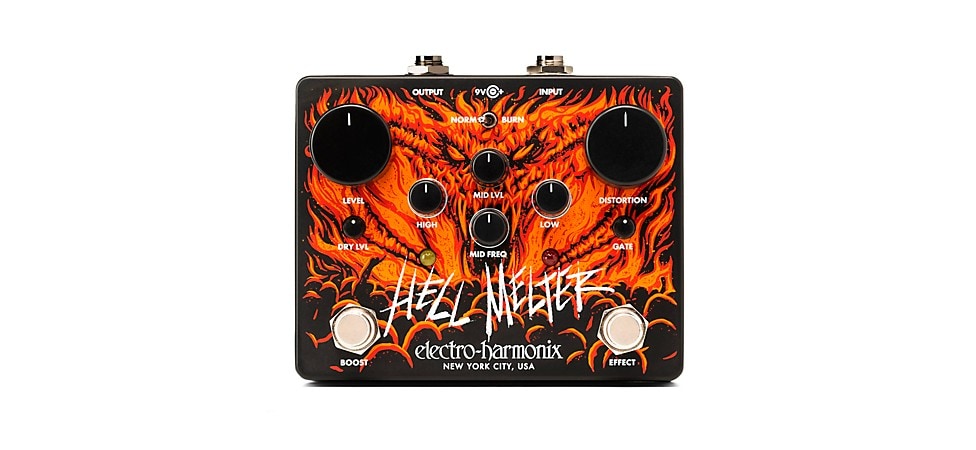
Pictured: Electro-Harmonix Hell Melter Distortion Pedal
Alongside legendary producer Tomas Skogsberg, Sweden’s Entombed defined a genre with Left Hand Path in 1990, and the Electro-Harmonix Hell Melter distortion reinvents the symbolic HM-2 pedal for the modern era. In Burn mode, the Hell Melter boasts greater headroom, an open, less compressed sound and more precise attack, additionally utilizing an alternative clipping style. From a sonic standpoint, Normal mode returns players to the secluded woods where Swedish death metal was born.
An active 3-band EQ with a semi-parametric midrange lets you dial in (or out) that unmistakable buzzing grind, while a built-in noise gate keeps the signal clean. There’s even an extra gain stage at the beginning of the circuit that kicks on with the Boost footswitch, driving the pedal harder and varying its hard-clipping structure throughout. The EHX Hell Melter is a grisly standalone distortion, but it also plays friendly with other gain pedals thanks to an onboard wet/dry blend.
Fender Pugilist Distortion
Why You Want to Buy It: The Fender Pugilist contains a pair of stackable distortion engines for everything from mild-mannered breakup to blasphemous brutality.
Things to Consider:
- Magnetically latched 9V battery compartment (also runs on 9V DC)
- LED-lit knobs with on/off capability
- All-original Fender design
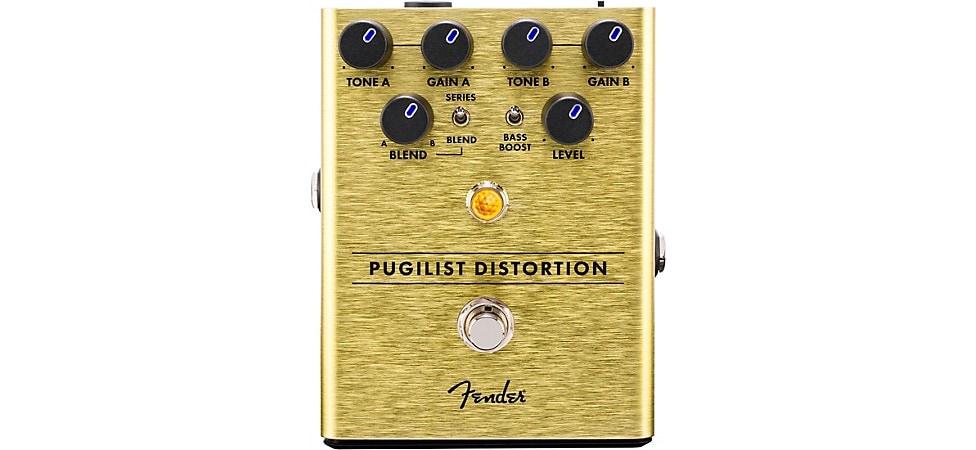
Pictured: Fender Pugilist Distortion Pedal
Punch up your drive with the Fender Pugilist Distortion, built with a pair of gain engines sporting discrete, per-channel tone sculpting. Given the ability to run Gain A and B in series or as a custom blend, there’s an array of distortion at your feet and fingertips, from high-gain assault to crunchy rock. Independent tone knobs brighten or darken the sound for fast, intuitive EQ that’s musical and responsive, and a Bass Boost switch gives your low end a bit more “oomph,” should you need it.
Stage-ready, the Pugilist Distortion features illuminated parameters with an option to turn the LEDs on or off at the flick of a switch. Everything about this pedal was designed with active players in mind, right down to the magnetically latching 9V battery door for quick swaps on stage or in the studio. Aesthetically, the Pugilist comes with a cool Fender amp jewel LED for a touch of classic vibe.
JHS PackRat Distortion
Why You Want to Buy It: The JHS PackRat is a tribute to what is arguably the most influential distortion pedal of all time, containing nine distinct voices spanning its nearly five-decade history.
Things to Consider:
- True bypass operation
- Digitally controlled, fully analog circuitry
- Inspired by the RAT’s impact on electric guitar
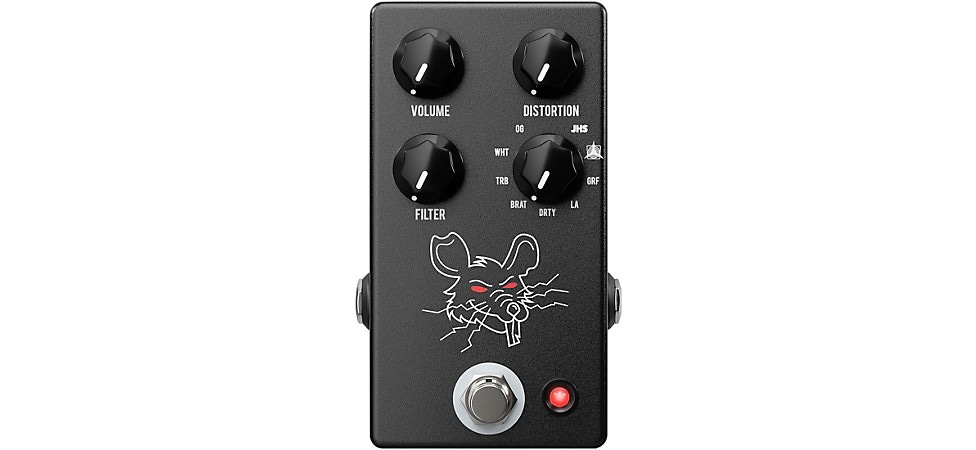
Pictured: JHS Pedals PackRat Distortion Pedal
The JHS PackRat is a love letter to the renowned “rodent-style,” hard-clipping distortion pedal of the late ’70s and beyond. Joshua Heath Scott is a RAT connoisseur, having spent years researching, playing and modifying them, and his unique expertise informs the nine meticulously recreated tones housed in this pedal. The PackRat faithfully captures the fuzz-distortion sound of OG V1 models produced between 1979 and 1983, as well as V3, V5, V6 and V7 iterations from the mid-80s to the 2000s.
We’re not biased, but the BRAT (V6) mode is certainly one of our favorites. In 1996, ProCo inked a deal with Guitar Center to develop an exclusive, budget-friendly pedal, ultimately dubbed “Roadkill.” Its sound is profoundly ’90s grunge influenced and represents the greatest evolution of the circuit at that time. Shortly after, ProCo released the non-exclusive BRAT, with the same “guts” as the Roadkill, modeled here in the JHS PackRat.
Rounding out the rat’s nest are three modified RAT-style pedals JHS procured from other developers, including the Ibanez LA Metal from 1986, a 1999 Landgraff MO’D and a 2010 Caroline Wave Cannon. Last but not least, JHS Mode retains the true character of the original with a few of Scott’s favorite modifications.
Keeley Filaments Distortion
Why You Want to Buy It: The Keeley Filaments mimics high-gain tube amp distortion by internally layering three gain stages.
Things to Consider:
- True bypass operation
- Voltage of power supply alters tonality
- Primarily aimed at metal players
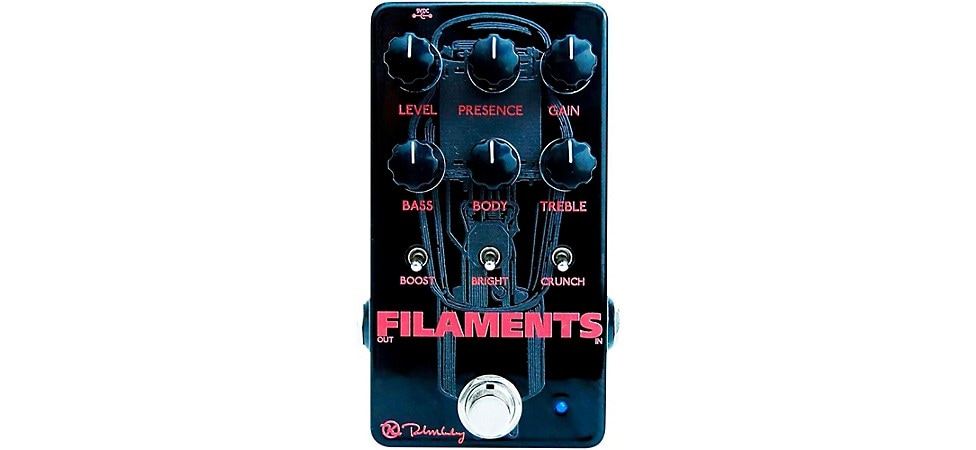
Pictured: Keeley Filaments Distortion Pedal
The Keeley Filaments distortion pedal offers searing tone at practical volumes, comparable to the roar of a raging high-gain head. By stacking three gain stages and providing seven ways to EQ and fine-tune your sound, Filaments is armed to take on modern progressive metal, old-school thrash and virtually any style of aggressive music in between. If you’re mindful of its settings, it’s even possible to coax out overdriven crunch for blues, rock and other lower-gain stylings.
Bass and Body controls work together to shape the low-end response of the pedal, shoveling mud or beefing up an anemic tone. Boost and Crunch switches offer their own gain and compression levels, while a Bright switch opens up your guitar’s voice with a top-end push. Tweaking both Presence and Treble parameters lets you dial in just the right amount of bite and air, and they’re especially useful for down-tuned or extended-range instruments with a lot of natural low end.
Should you power the pedal with 12 or 18 volts instead of the standard 9V, you’ll notice an increase in overall volume and additional clean headroom—the latter is handy for making the gain sweep more gradual.
MXR M104 Distortion+
Why You Want to Buy It: Another breakthrough pedal of the late ’70s, the MXR Distortion+ is a no-frills dynamite stick of explosive saturation.
Things to Consider:
- Ultrasimple layout and operation
- Powered by a 9V battery or 9V DC supply
- Germanium diode clipping
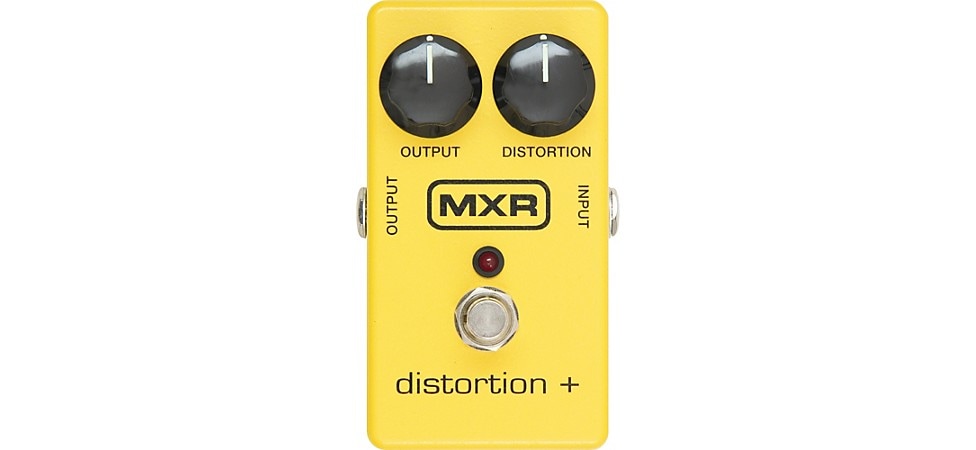
Pictured: MXR M104 Distortion+ Pedal
Sometimes two parameters are all that’s required, and the MXR M104 Distortion+ proves it. Between volume and gain, the M104 covers a ton of ground—keep the Distortion knob low and dime the Output to work it like an overdrive, or dial up the madness for breakup that’s borderline fuzzy.
It’s lean, it’s mean and it’s a distortion pedal that can take you from bluesy crunch to massive ’80s-tinged hard rock in zero seconds flat. The MXR Distortion+ has been serving deliciously destroyed tones for players of all stripes since 1977.
ProCo RAT2 Distortion
Why You Want to Buy It: Praised for its versatility and ease of use, the venerated ProCo RAT is one of the most celebrated and imitated distortion circuits ever made.
Things to Consider:
- Fully analog signal path
- No-tools 9V battery compartment and 9V DC input
- Extremely durable steel enclosure with a sloped face for easy stomping
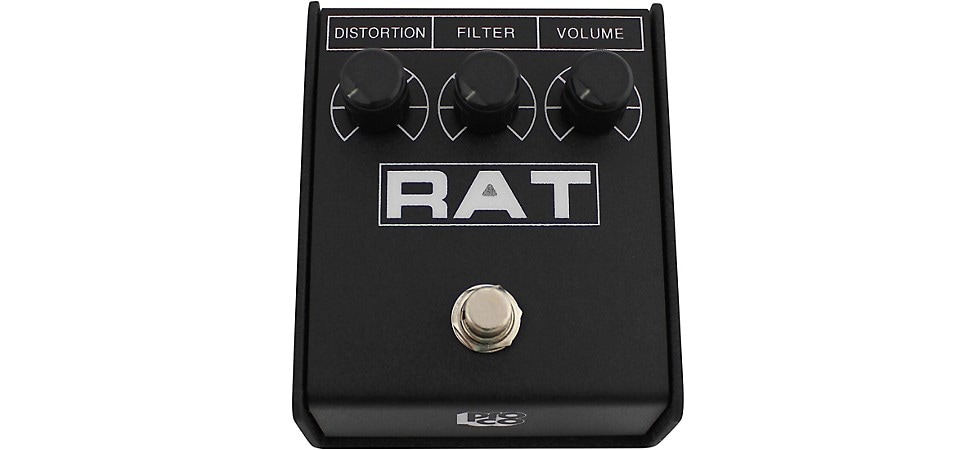
Pictured: ProCo RAT2 Distortion Pedal
The ProCo RAT2 is the current iteration of a classic that’s widely considered the gold standard in distortion pedals. Three streamlined controls—Distortion, Filter (of the low-pass variety) and Volume—open up worlds of saturated goodness. None of us would be the first to note just how impressively versatile the RAT is, housing everything from mid-hyped overdrive to tube-style distortion and square-wave fuzz in its virtually indestructible enclosure.
In the world of effects pedals, “iconic” is an apt descriptor for the ProCo RAT. It’s truly a special distortion pedal used on thousands of recordings by a who’s-who of music’s most influential artists. You can’t go wrong with a RAT—check out our complete guide to the ProCo pedal that’s left an indelible mark on guitar history.
Wampler Phenom Distortion
Why You Want to Buy It: The Wampler Phenom Distortion pedal is inspired by “5150”-style tones—go ahead and get crazy.
Things to Consider:
- JFET-based clipping
- Voltage of power supply alters tonality
- Amp-like touch sensitivity
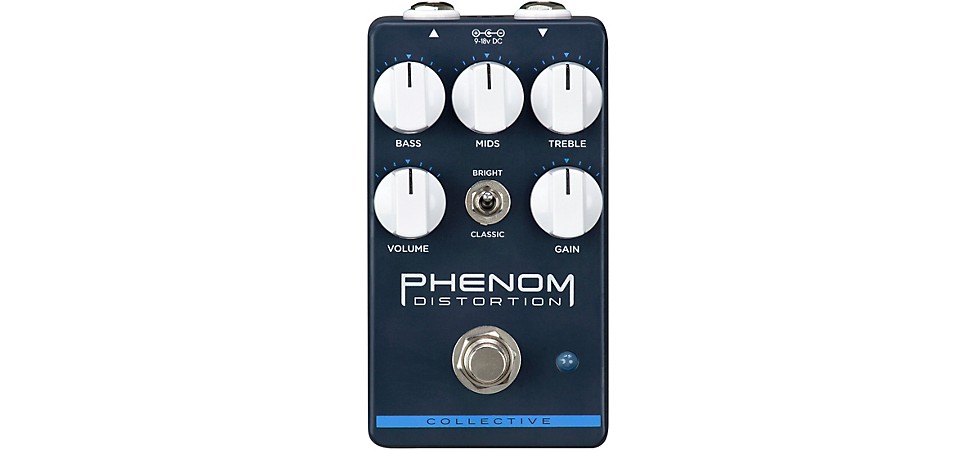
Pictured: Wampler Phenom Distortion Pedal
The Wampler Phenom Distortion is part of the Collective Series, offering guitarists on any budget high-quality, affordable pedals without compromise. Loosely based on legendary “5150” sounds, the dual-voiced Phenom features a Classic mode with liquid breakup and punchy lows, and a Bright mode with extra bite and aggression for cutting leads or searing riffs.
Its ingenious JFET circuit, designed by Brian Wampler, drives to saturation similarly to a tube amplifier, meaning this pedal sounds and feels a lot like the real thing. Single coils and humbuckers retain their unique characteristics and aren’t washed out by over-the-top solid-state distortion, and the pedal responds to playing dynamics, like how gently or aggressively you dig in.
Get Down and Dirty With a New Distortion Pedal
Distortion is an inherent part of the electric guitar’s sound. From the early rock days of pushing small tube amps into organic saturation to the evolution of high-gain metal—and the gear that makes it happen—distortion is a pivotal effect that’s helped define genres for decades. We’ve covered a handful of the best distortion pedals in 2025, but feel free to browse Guitar Center’s extensive used selection to find killer deals on the drive of your dreams.
Want to hear them in action? Stop by your local Guitar Center and visit the pedal table to sample a range of effects up close.




